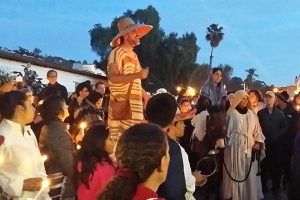
Fairies
In Ireland, fairies are referred to as the wee people or the good people. They have been known to protect - and sometimes trick - their human counterparts.
According to legend, there are two types of fairies: trooping fairies, who are extroverted and delight in company; and solitary fairies, who, like the leprechaun, prefer to be left alone.
Another solitary fairy is the banshee, also known as the Lady of Death or the White Lady of Sorrow. Her mournful wails may be heard when death or misfortune is about to occur in the beloved mortal family she watches over. This is where we get the expression “wail like a banshee.”
A changeling is a fairy baby left in place of a stolen human baby. Superstition dictates that before delivery, an expectant mother should nail a horseshoe to the doorpost, place a prayer book under her pillow and make the sign of the cross on a plate of salt. Once the baby is born, the new mother should position a candle so that the candle is the first thing the child sees when it wakes. This ensures that the baby will choose the acts of light over the deeds of darkness.
Leprechauns are known for their cobbling skills, their pots of gold at the end of rainbow and their ability to grant wishes.
The pooka is a fairy spirit who often appears in the form of an animal.
Folklore
According to Mike Dixon-Kennedy’s Celtic Myth & Legend, several of Noah’s descendants found their way to Ireland after the Great Flood, including Cesair, his granddaughter, and his son, who was said to have been among the first settlers of Ireland.
The rainbow is home to the leprechaun’s gold. Many folks believe that God placed a rainbow in the sky as a promise that he would never destroy the earth again by flood. Also known as the “Gateway to Heaven,” the seven-colored arc-shaped rainbow is considered a symbol of the reconciliation between God and man.
Tír na nÓg is the Land of the Young or the Land of Eternal Youth, according to Irish folklore. Oisín, the brave leader of the tribe of the Fianna, was told he may never return home if he followed Niamh, the beautiful daughter of the king of Tír na nÓg, to the Land of the Young under the sea. Oisín climbed on Niamh’s magic white horse and left his home and family behind him. They lived happily for 300 years until Oisín asked permission to visit Ireland. Niamh loaned him her magic horse with a warning that all his years would immediately come upon him if he ever dismounted. Oisín rose from the sea on Niamh’s magic beast and discovered that nothing was the same in Ireland. All the Fianna warriors were gone, and the country was full of sadness and strangers.
Slowly, Oisín headed back to the sea. Crossing the beach, Oisín saw what appeared to be Fiannan armor on the sand. Forgetting Niamh’s warning, he stepped down from the magic white horse and three hundred years descended on him. They say the sea raged that day, as the Land of the Young mourned the brave warrior the mortal world seized away.
Fun Facts
The mythical unicorn was made famous when the Irish Rovers recorded “The Unicorn” in 1967. The Irish Rovers’ song about “green alligators and long-necked geese, some humpty-backed camels and some chimpanzees” is based on Shel Silverstein’s whimsical collection of poems.
The Dublin Zoo is the world’s third oldest public zoo, and is noted for having bred the first lion cubs in captivity in 1857. It is also known as the home of the legendary cat that “yawns” at the beginning of the famous MGM films.
---------------------------------
Erin Ruocco’s great-grandparents—Martin McGrath and Mildred Murphy—were born in county Galway, Ireland. Erin was born and raised in Boston, Massachusetts, with a 30 percent Irish population. This freelance bard now makes her home in Poway. “Erin Go Bragh” (Ireland Forever).







